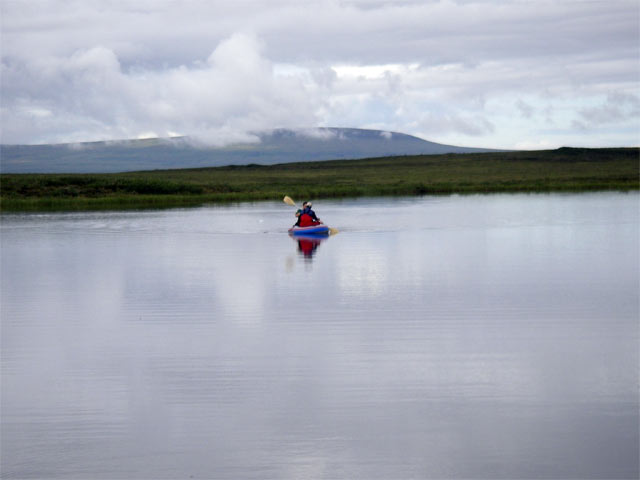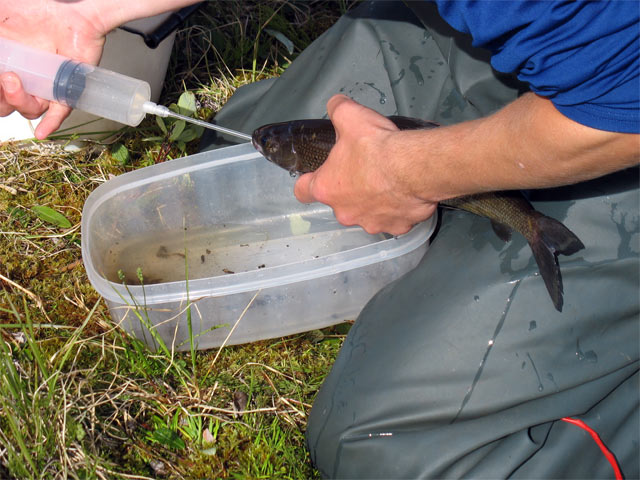( Log In ) Log In is for TREC Teachers & Researchers only
  |
| Charla_Jordan |
 Jul 31 2006, 05:31 AM Jul 31 2006, 05:31 AM
Post
#1
|
 Advanced Member    Group: TREC Team Posts: 36 Joined: 12-April 06 Member No.: 28 |
July 26, 2006 Part I Aquatic Research
Morning Temperature 65, Rainy Afternoon Temperature 78, Sunny Day 3 of the Pluck Today is the third day of our research team’s pluck. Everyone is going a little stir crazy. So, I was pleased to be invited to join two aquatic research teams today in the field. To get to the lakes that the teams are studying, we must take the helicopter.  Toolik Fields’ helicopter We all rode out to the lakes in shifts; helicopters can only hold so much weight. The first group that I worked with that morning was a research group from University of North Carolina. They have studied many lakes in the area and must bring a great amount of gear where ever they go, including two rubber boats and a pump plus all of their testing equipment, all packed away in backpacks.  Ken Fortino is a PhD student who is researching whole lake respiration and carbon metabolism. Dendy Lofton is also a PhD student who is researching inorganic and organic nitrogen cycles in the arctic lakes. These two are joined by Matthew Harrell, an undergraduate who is majoring in Environmental Studies. The morning started with Ken and Matthew going out to pull up sediment traps. These devices are placed in the lake and literally catch whatever sediments are falling down in the water. They are later analyzed in the lab.  Dendy and I went out in another boat to run several test and collect water samples. We tested for dissolved oxygen levels, use a succi disk to check the clarity of the water (the water was so clear you could see the bottom of the lake at 4.3 meters), measured temperature, and measured for light intensity penetration. Dendy also had to collect water samples at various levels in the water (Ex: 0.5 m, 1m, 1.5m, etc.). She used a device that would capture the water samples at the exact level she needed them at.  Lowering the Van Dorn Sampler into the water  After collecting the water, the sample is then put in container, frozen in the lab, and shipped back to the university for testing. Meanwhile Ken and Matthew had finished collecting the sediment traps—which would be tested for the sedimentation rate in that lake. They had also collected sediment cores which would be tested in the lab to measure the amount of chlorophyll in them. All of the results of these tests would be applied to their research projects.  The sediment traps and the collected samples out of them.  Ken and Matthew breaking for lunch These researchers are very diligent and have tested many lakes in the area. By the way, there are many tundra lakes in the area and they are not named—they are given a numeric name such as Lake 156. In the afternoon I switched lakes and started observing another aquatic research team. Cody Johnson is a PhD student at the Utah State University. He is doing research in the aquatic ecology. Dan Garr is assisting and has a BS in fishery and aquatic science. These guys have the best job in the world—they get to fish all day! They have been studying arctic lakes catching fish, measuring length, weight, tagging them, and flushing out there stomachs to see what they have eaten. They catch fish such as Arctic Grayling and Trout. Cody and Dan also collect sediment samples to see how fast sediment is accumulating on the bottom of the lake. Tracer isotop nitrogen 14 is added to the lakes to track the nitrogen in the food chain.  Cody has weighted and measured length on the fish  Cody is inserting a tagging device into the fish so that the fish can be tracked through the years for growth.  A rubber coated needle is inserted into the fish’s stomach and washes out the contents. Cody and Dan collect the sample and take it to the lab to identify the contents and count the amounts. These guys have a great job! So ended my day in the field—back to the pluck. We returned to camp around 5:00 pm, I ate dinner, then plucked until 10:00 pm. ***Question of the Day: Would you expect an Arctic fish to be larger or smaller than a Texas fish? Post your answer in the “Ask a Teacher Section”. |
  |
2 User(s) are reading this topic (2 Guests and 0 Anonymous Users)
0 Members:

|
NSF Acknowledgment & Disclaimer | Time is now: 10th November 2024 - 02:10 PM |
Invision Power Board
v2.1.7 © 2024 IPS, Inc.








